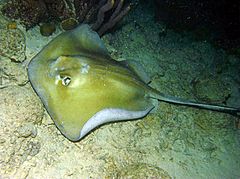Stingray facts for kids
Quick facts for kids Stingrays |
|
|---|---|
 |
|
| Southern stingray, Dasyatis americana | |
| Scientific classification | |
| Kingdom: | |
| Phylum: | |
| Class: | |
| Subclass: | |
| Order: | |
| Suborder: |
Myliobatoidei
|
The stingrays are a large suborder of the rays. They are cartilaginous fishes related to sharks. They are classified in the suborder Myliobatoidei of the order Myliobatiformes, and consist of nine families.
Most stingrays have one or more barbed stings on the tail, which is used only for self defending. The sting may reach about 35 cm, and its underside has two grooves with venom glands. The sting is covered with a thin layer of skin, the sheath, in which the venom is held. A few members of the suborder, such as the manta rays and the porcupine ray, do not have stings.
Stingrays are common in coastal tropical and subtropical marine waters throughout the world. There are species in warm temperate oceans, and some found in the ocean. Some live in fresh water. Most stingrays live at or near the bottom of the water, but some are pelagic.
Fatal stings are very rare. The death of Steve Irwin in 2006 was only the second recorded in Australian waters since 1945. The stinger pierced his heart.
Contents
Lifestyle
Stingrays settle on the bottom while feeding, often leaving only their eyes and tail visible. Coral reefs are favorite feeding grounds and are usually shared with sharks during high tide.
The flattened bodies of stingrays allow them to hide themselves. Stingrays agitate the sand and hide beneath it. Because their eyes are on top of their bodies and their mouths on the undersides, stingrays cannot see their prey. They use smell and electro-receptors similar to those of sharks.
Stingrays feed mostly on molluscs, crustaceans, and occasionally on small fish. Some stingrays' mouths contain two powerful, shell-crushing plates, while other species only have sucking mouthparts.
Reproduction
Stingrays are ovoviviparous, bearing live young in 'litters' of five to thirteen. The female holds the embryos in the womb without a placenta. Instead, the embryos absorb nutrients from a yolk sac, and after the sac is depleted, the mother provides uterine 'milk'.
At the Sea Life London Aquarium 2 female stingrays have delivered 7 baby stingrays, although the mothers have not been near a male for 2 years. "Rays have been known to store sperm and not give birth until they decide the timing is right".
Like all fish, stingrays sometimes get little parasites (such as flukes or copepods) on their gills or body. A cleaner fish helps the stingrays by eating those parasites it can get at.
Families
There are eight families in the stingray group. They are:
- Hexatrygonidae (sixgill stingray),
- Plesiobatidae (deep water stingray),
- Urolophidae (stingarees),
- Urotrygonidae (round rays),
- Dasyatidae (whiptail stingrays),
- Potamotrygonidae (river stingrays),
- Gymnuridae (butterfly rays), and
- Myliobatidae (eagle rays).
Images for kids
-
Early Eocene fossil stingray Heliobatis radians
-
Spotted eagle rays are widespread along Atlantic coasts
-
Ocellate river stingrays are found in South American rivers
-
Diver interacting with a short-tail stingray
-
[Undulate ray]]s are endangered from overfishing
-
[Leopard whipray]]s are vulnerable from overfishing
-
[Bluespotted ribbontail ray]]s are near threatened
See also
 In Spanish: Myliobatoidei para niños
In Spanish: Myliobatoidei para niños














